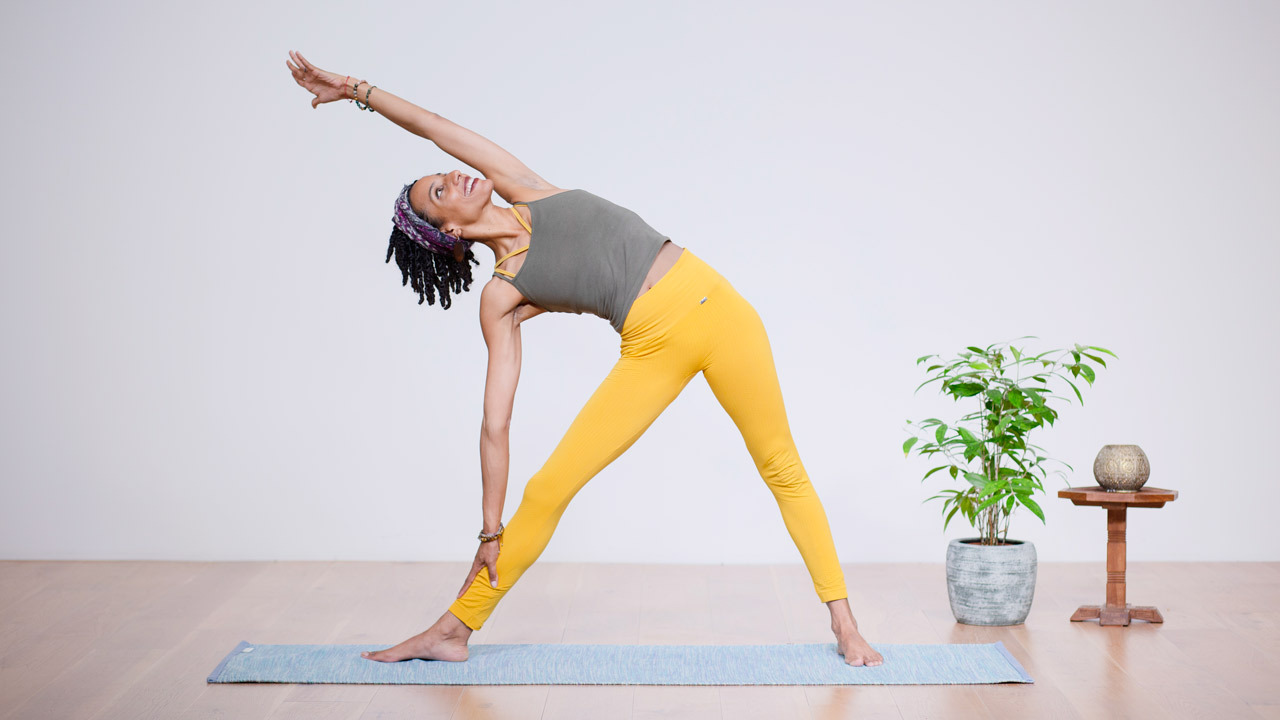What exactly is core strength?
What comes to mind when you think of ‘core strength’? Sit ups and six packs? Crunches and gruelling exercise sessions focused on building abs? The truth is, having a strong core actually has nothing to do with traditional abdominal exercises at all, and they can often do more harm than good…
Building a strong core encompasses both physical and psychological aspects; when we feel strong in our core, we often also feel mentally strong, resilient and empowered, and we’re also much less likely to experience back pain or injuries when engaging in everyday activities. In this article, you’ll learn why core strength is so important, the link between your core and your emotions, and the 10 best yoga poses for building core strength.
Why is core strength important?
Every movement you do throughout the day; from walking to cleaning, getting out of the car and even transitioning from sitting on the sofa to standing up involves your core. Some of the most common issues such as lower back pain, knee pain, and problems with the IT band and ankles can all occur due to having a weak core. Your core helps stabilise your body through its movements, which in turn allows you to move with more mobility and flexibility. When running for example, the core muscles help the pelvis, hips and lower back work together without expending excessive amounts of energy. If your core is weak, its likely these parts of the body will be over-working, potentially leading to injury. In your yoga practice, core strength helps you move smoothly through sun salutations and vinyasa flow sequences, as well as supporting your ability to balance.
What is the core made of?
You may be surprised to know that there’s a lot more to your core than simply your stomach muscles. In truth, your entire core is much more like an apple core, running throughout your whole body. Through the work of Thomas Myers’ ‘Anatomy Trains’, which explores connective tissue known as fascia throughout the body, we now know that your ‘core’ actually stems from your feet all the way up to your head! Here’s a little guide to your core, also known as the ‘deep front line’ of fascia, which runs through the very centre of your body, it runs through:
- The arches of your feet
- Your knee joints
- Adductors (the muscles on the inside of your thighs)
- Pelvic floor
- Hip flexors
- Lower spine
- Diaphragm
- Muscles of your neck
As you can see, your core resembles much more of an apple core running through your body, than a small area on your stomach. Your core also wraps around your mid-section, supporting your abdomen, waist and lower back. Your core is made up of an interconnected network of muscles and connective tissue meandering throughout the central line of your body.
The emotional impact of your core
Have you ever heard the concept that we store our ‘issues in our tissues’? Indeed, according to thousands of years of wisdom from the East and new emerging research in the West, it seems we hold emotions within our physical bodies, and the way we move has a big impact upon how we feel mentally. Sitting in a hunched and scrunched over position when working at a desk, driving or staring down at a phone screen can cause the muscles and connective tissue of the core line to become ‘tight’ and restricted.
Why sit-ups are bad news!
If we take a look back at the list of body parts the core runs through, we can understand that if our core is tight and restricted, it will also be causing issues for the pelvic floor, hip flexors, diaphragm and neck muscles – all parts of the body that commonly store a huge amount of tension. Imagine the shape of your body in a crunch or sit-up position then; it mirrors a hunched-over posture, which spells bad news for our breathing and emotional health. One of the most important aspects to focus on when it comes to core strength then, is cultivating a strong, long and functional core, rather than one that is tight and scrunched up.
Core strength and its connection to self esteem
Another important emotional aspect of core strength is the connection it has to our sense of empowerment and self-esteem. The Manipura Chakra (also known as the ‘solar plexus’) is found in the centre of the body, and very much relates to feeling powerful in our core. This energetic centre represents power, energy, intellect, transformation, strength and our ability to feel strong and confident in the world. When we practice yoga postures for building core strength, we’re able to increase our inner strength as well as our outer strength, and enhance our sense of confidence and ability to handle whatever life brings our way.
What’s at the core of your being?
Finally, there’s another aspect of your core that lies way beyond the physical; what’s at the very core of your being? Throughout the yogic texts and traditions, there are many teachings that guide us to deeply connect to the very core of who we truly are. The word ‘yoga’ translates as to ‘yoke’, which means to ‘unite’ or ‘connect’ with divinity and who we truly are, and it can also refer to the ability to disconnect from who we are not. When we think about building a strong core then, yoga practices like meditation, introspection, self-study, as well as journaling and time simply spent in quietness can all help us access the core of who we really are. To connect your physical core to the core of your being, try Esther’s A Journey Through The Core of Your Being class.
So, now you know what your core is, where is it and what it truly means to cultivate core strength, let’s discover the 10 best yoga poses for building core strength:
The 10 best yoga poses for building core strength
1. Tadasana & Core Visualisation
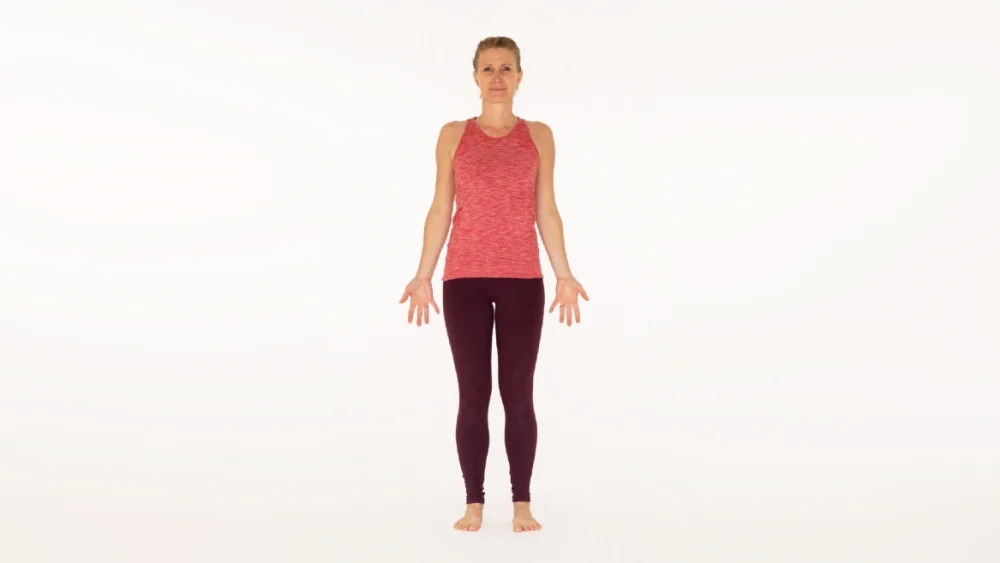
The first of our poses to build core strength may seem too simple, but this is where the connection to your core comes from – through visualising and feeling it in your body. Even in a posture like Mountain Pose, where it seems as though the body isn’t doing anything at all, our core muscles are supporting us all the time.
To practice, stand with your feet roughly hip distance apart and your shoulders rolled down and back. Become aware of the inner arches of your feet and even practice engaging them by raising the inner arch as much as you can. Next, move your awareness to your knees, to your inner thighs and your pelvic floor, engaging and releasing it a few times to feel your core working. Move your awareness to your hips and lower back, and your diaphragm – take a deep breath in and out here to feel your core muscles working again. Bring your awareness to the muscles of your neck, then work your way back down again.
- Practice Nahid de Belgeonne’s Find The Core Line class to connect to your deep core line without a sit up in sight!
2. Extended Hands & Knees or ‘Bird Dog’
This pose is great for warming up the body in preparation for stronger postures, for those who are recovering from injury or postpartum, or beginner yogis too. It may seem easy, but this pose will really test your core strength and help engage muscles along the deep core line. Just remember to breathe! To practice, begin on your hands and knees. Extend one arm out in front of you at shoulder height, and the opposite leg back behind you, keeping it level with your hips. Your core will be a big supporter of your back here, ensuring your mid and lower back don’t ‘dip’. Engage your pelvic floor and abdominals to keep you stable for 3 to 5 breaths, then switch sides.
- The Core Power With Pilates class with Marlene Henny will give you lots of simple yet very effective core strength poses to work on, and is also great if you suffer with lower back pain.
3. High Lunge
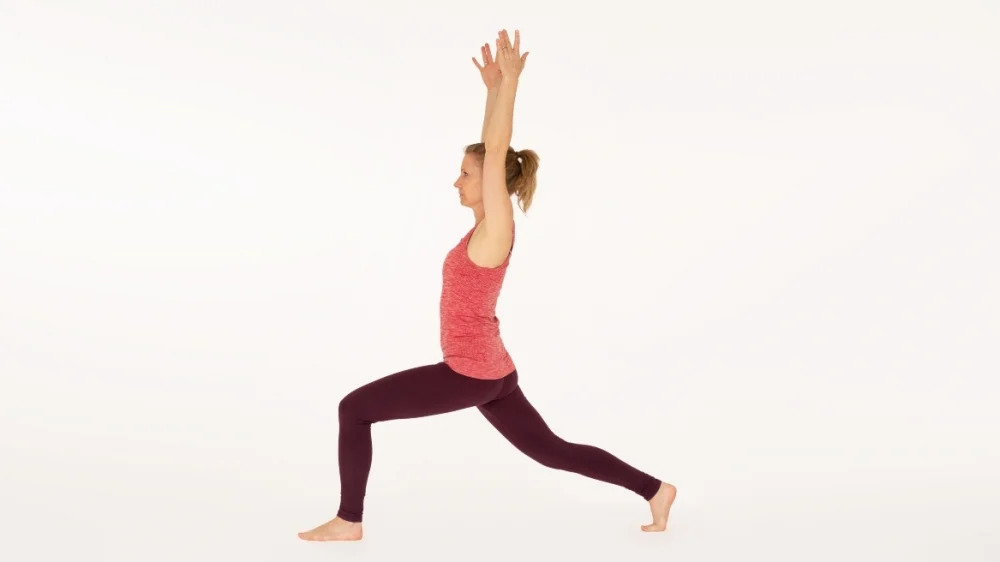
Similar to Warrior 1 but with the back heel raised, a high lunge position requires lots of support from the core to keep you stable and balanced. Core strength helps us stay steady in this posture without wobbling, which then allows us to build more strength in the legs and hips. To practice, take a long step back with your left foot and keep your heel lifted. Explore taking your feet hip distance apart or on a ‘tightrope’ to see what feels better for you. Hold for 3 to 5 breaths, then switch feet.
- A Full Hour of Power with Mark Mostaed contains plenty of standing poses in this strong core-focused class.
4. Tree Pose
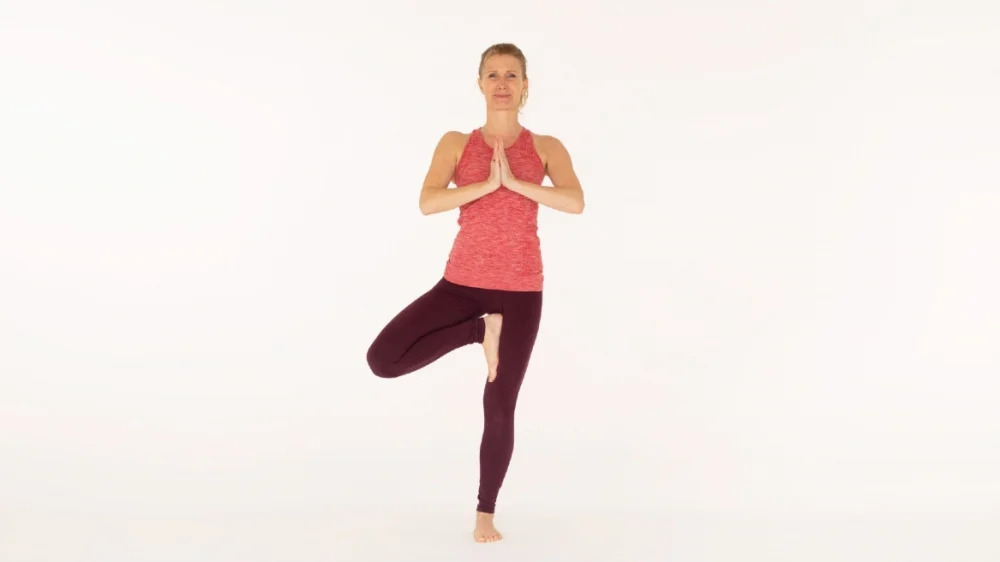
Balancing poses will soon help you realise how strong your core is. Remember that our core helps provide stability, so the stronger your core, the easier you’re likely to find balancing. Tree pose is also a great posture to help us connect to the deep core line.
To practice, stand in Tadasana and lift one leg, placing your foot to the inner edge of your other leg. Place your foot on your lower leg or inner thigh, but avoid pressing into the knee joint. Bring your palms together at your chest, or above your head for more of a challenge. In this pose, you may be able to feel the inner arches of your feet and inner thigh muscles of the deep core line supporting you. To enable your core to work more efficiently, focus on pressing your standing leg into your foot, and not pressing your foot into your standing leg. This can make a big difference when it comes to feeling steady. Practice using ‘mula bandha’ or the lift of your pelvic floor to further engage your core in this balance. Hold for 5 to 10 breaths, then switch sides.
- The Mula Bandha: A Tutorial For Women class with Francesca Giusti will help you understand how to lift and release your pelvic floor, whilst Pada Bandha – Wake Your Feet, Wake Your Spine! With Aki Omori will help you practice engaging your feet to engage the rest of your core.
5. Trikonasana
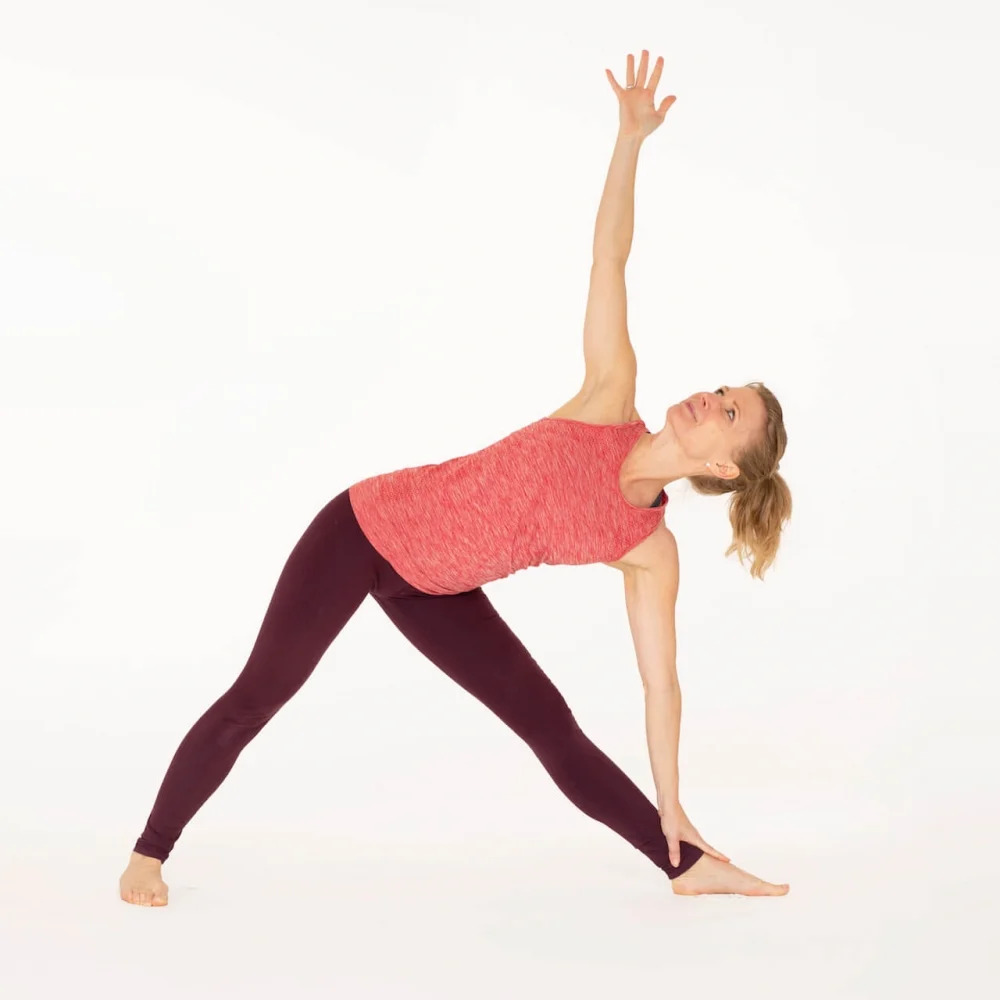
Core strength plays a big part in helping hold this pose for any amount of time, and protects us from injury too. When your core is fully involved in this pose, it’s possible to feel light and expansive, stretching out into the triangle shape.
To practice, step your feet wide apart and turn your right foot out to face the front of your mat. Keeping your legs straight, extend your right arm down your leg as far as is comfortable, keeping a lengthened spine. Extend your left arm up to the sky, so that your left hand creates the top corner of the triangle, and your feet are the two bottom corners. Engage your core all the way from the inner arches of your feet and hold for 3 to 5 breaths before switching sides. For extra points (!), you could try extending your hand arm towards the front end of your mat ( as shown in the main image of this article).
- Practice with Julie Martin in her Developing Core and Stability class, which is great for newer students, as well as those with more experience.
6. Plank
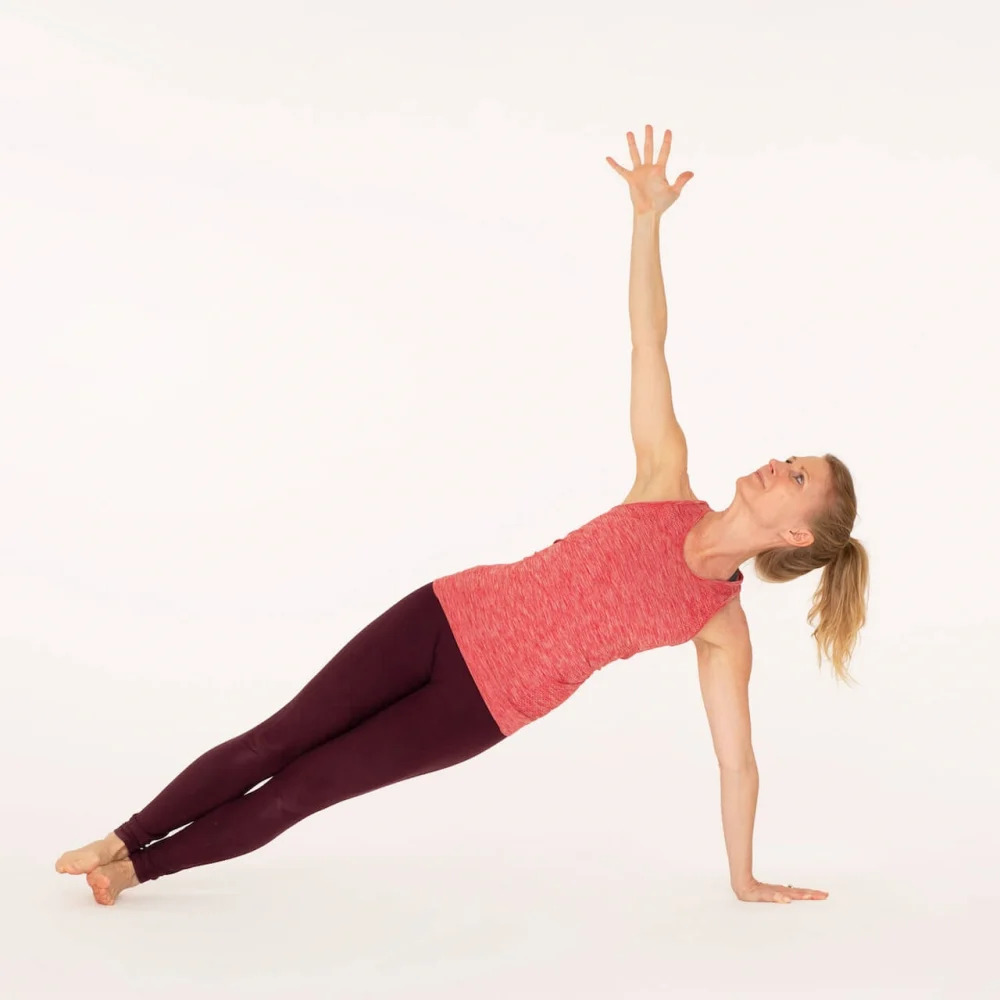
A classic core-strengthener, plank pose is something you’re likely to come across in many dynamic yoga classes as you transition from downward facing dog, through chaturanga to upward facing dog. The pose requires a strong core, upper body and wrists, but you can begin by placing your knees on the floor too until you’ve built up a strong core. Plank pose also helps us understand the balance of sthira (steadiness) and sukha (ease), which we need a balance of in any pose; keep your body strong but your breath and jaw muscles relaxed, which will tell your brain to relax even in a challenging situation.
When you feel confident in plank pose, you can add on more core-strengthening variations such as hovering one foot or one hand. To practice, begin on hands and knees, ensuring your wrists are underneath your shoulders or very slightly ahead of them. Walk your knees back so your torso is extended and your core begins to engage – be sure not to let your midsection dip towards the ground. If you’re feeling good here, extend your legs out into a full plank pose.
- Get your heart pumping in Sandra Carson’s Core Yoga Workout class, helping you build all-over strength with fun core-focused poses.
7. Side Plank
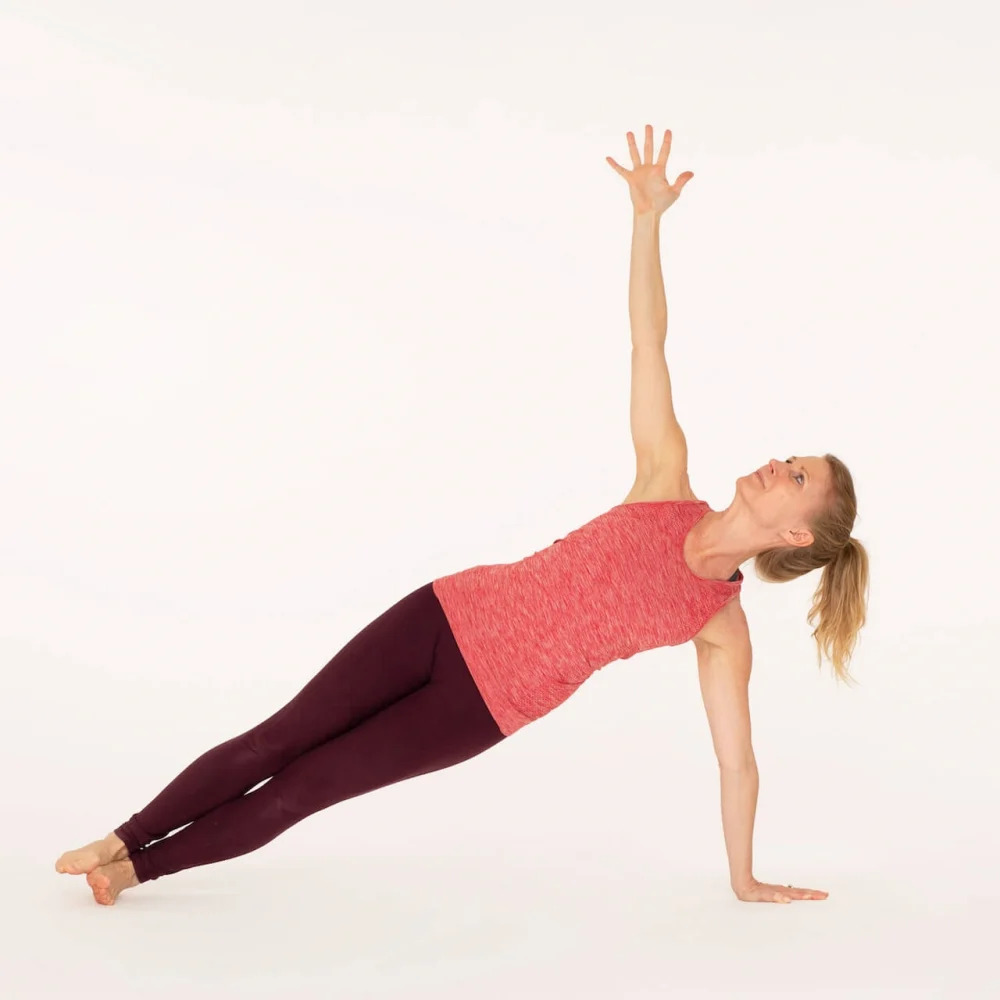
The oblique muscles are an important part of the core, helping us side bend and twist, and you can help strengthen them in a side plank pose. This posture is a great option to work up to when you’re feeling strong in plank pose and want to add in some fun variations. To practice, begin in a plank pose and turn your feet to one side, so that the edges of your feet are on the ground. You can stack your feet so that only the outer edge of one foot is on the ground, or keep both feet on the ground for more support. Lift one arm up to the sky and focus on keeping your hips lifted away from the floor. Again, find the balance of sthira and sukha, keeping your body strong but your breath and face muscles soft.
- Learn how to practice side plank in Vasisthasana or Side Plank Tutorial with Laia Bove, and play with variations of side plank in a challenging Side Plank Power flow with Tashi Dawa.
8. Forearm Plank or ‘Dolphin plank’
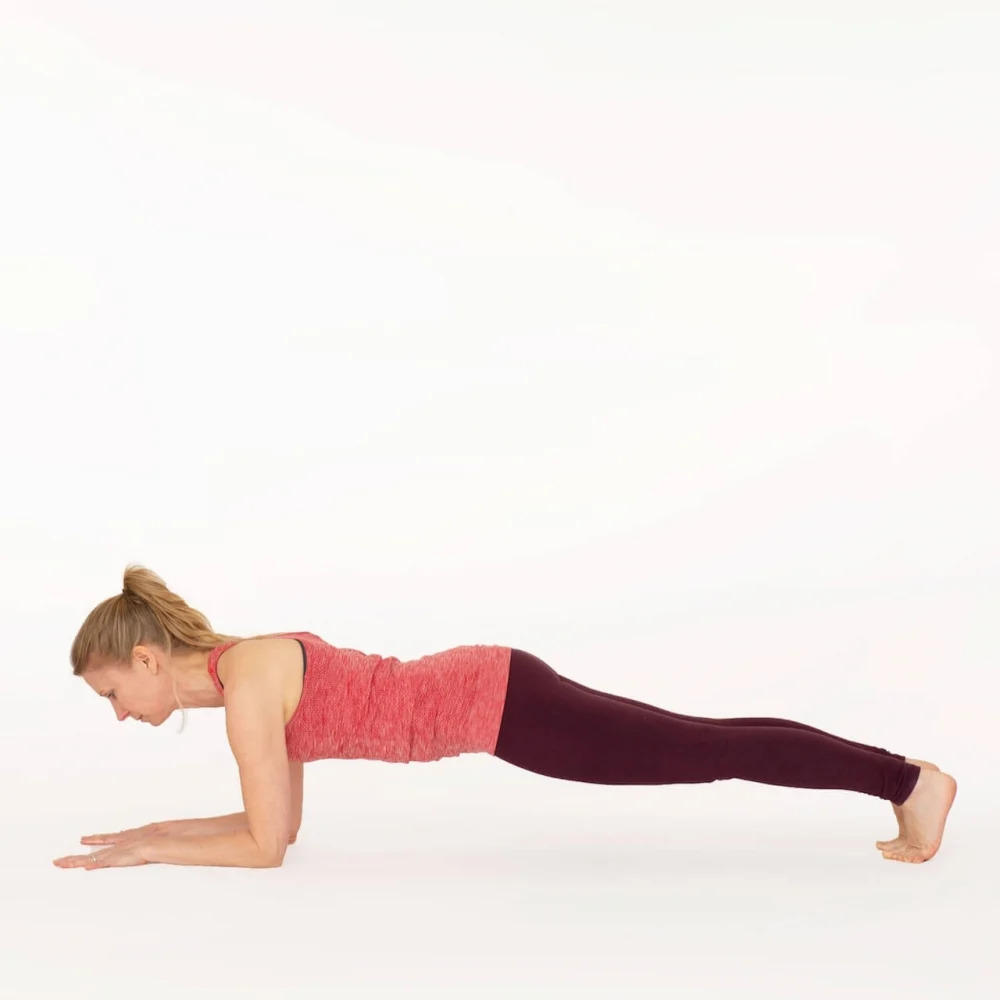
Our final plank variation is a little easier on the wrists, but will help build both inner and outer strength. Forearm plank, or ‘dolphin plank’ as it is sometimes known, is simply a plank practiced on the forearms instead of the wrists. It’s a great pose for building a long, strong core, and if you practice Ether’s A Journey Through The Core of Your Being class, she’ll help you work up holding it from 30 seconds to a minute. To practice, begin on hands and knees, then place your forearms on the ground with hands extended away from you. Keep your elbows underneath your shoulders and draw your shoulders back away from the ears. Extend your legs out with toes tucked under and your spine straight. Practice using mula bandha (lifting the pelvic floor) to further engage your core.
- This Strengthening Fun class with Esther Ekhart includes side plank, core planks, forearm plank and much more to help you feel empowered and strong.
9. Dolphin Pose
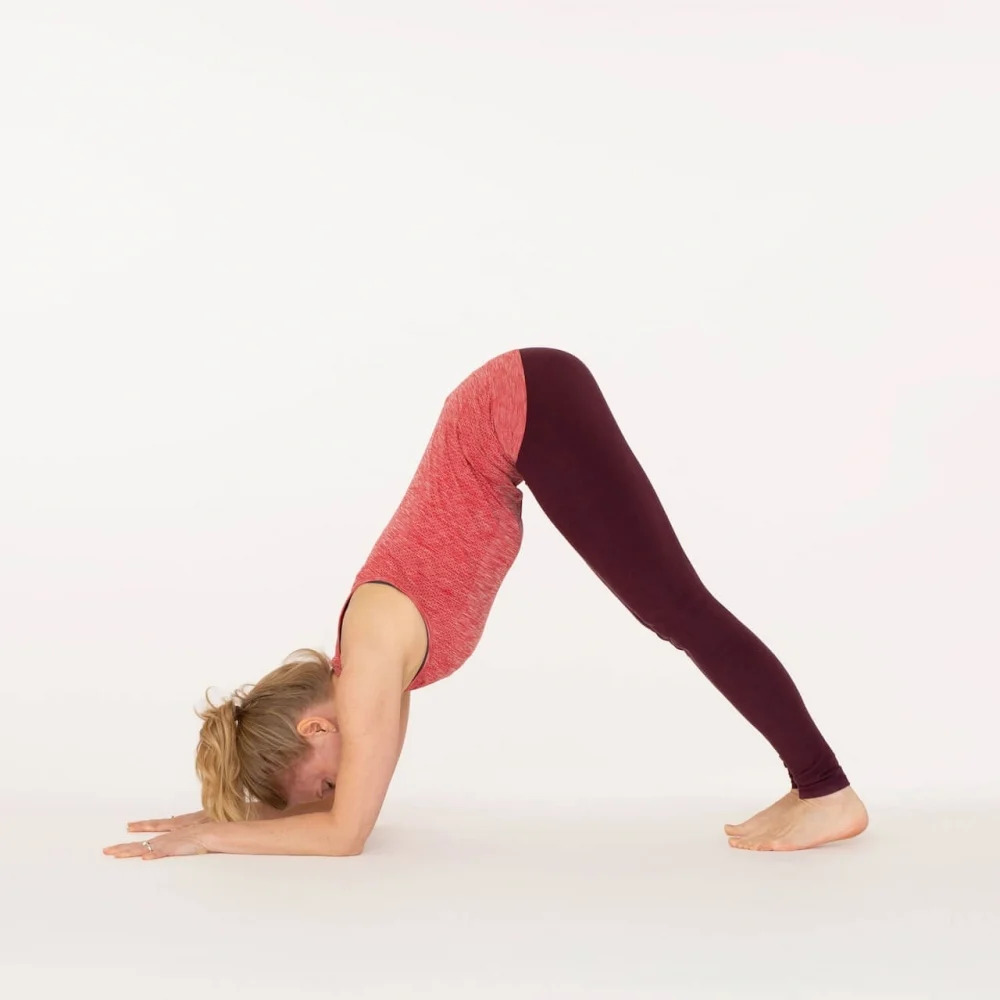
The name of this pose may sound cute and friendly, but it’s a challenging posture that builds tonnes of upper body and core strength. Again, this is a great pose to build inner and outer strength and confidence too. To practice, begin in a forearm plank position, then walk your feet up towards your arms. This pose is a little like the cousin of downward facing dog, so think about keeping your spine lengthened, and bend your knees a little if needed. Draw your shoulders back away from the ears to engage your back muscles in this pose, and keep your breathing soft. From here, you can play with variations such as lifting each leg, and prepare for inversions such as Pinacha Mayurasana.
- In Work Those Arms! With Mark Mostaed, you’ll flow through a Core Strength Vinyasa sequence with plank variations and poses to help you feel stronger inside and out.
10. Navasana
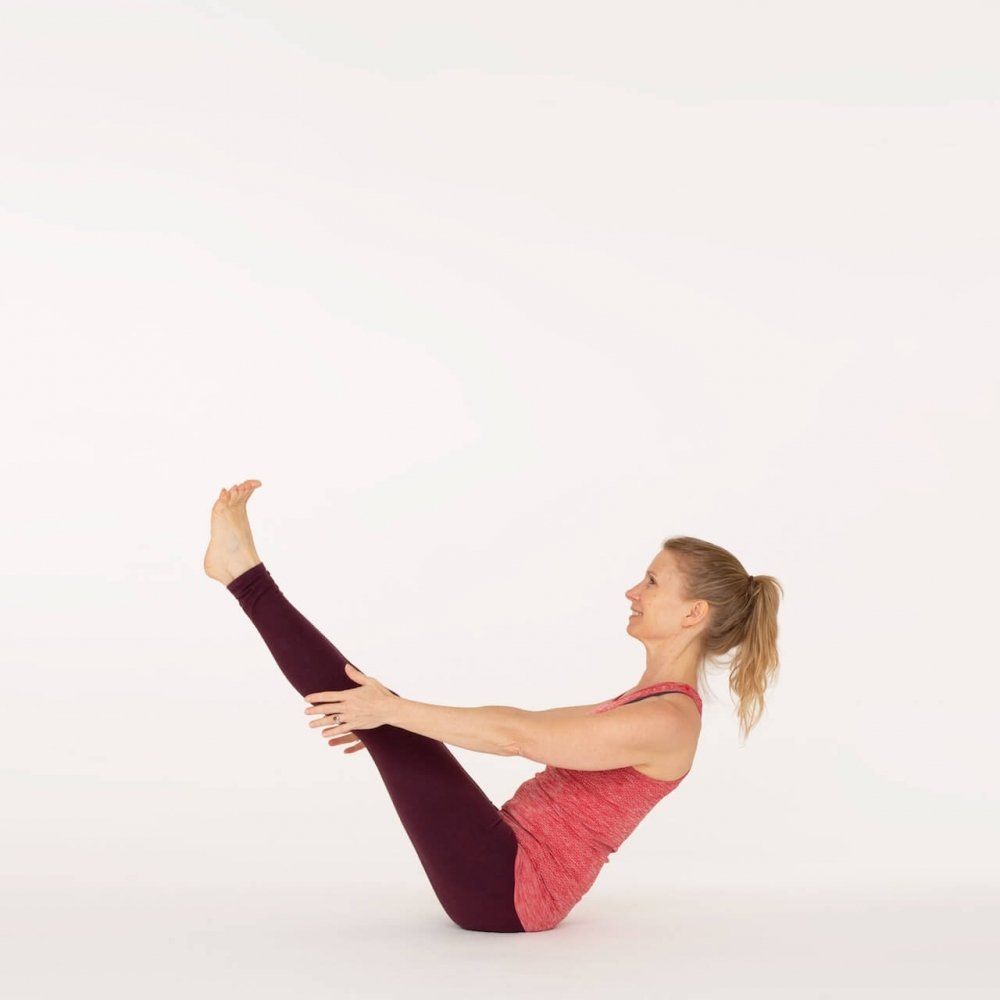
Probably as close to a traditional ‘core’ exercise as you’ll get in a classical Yoga posture, Navasana or ‘boat pose’ is a very strong posture that engages most of the muscles on the front of the body. Navasana works directly upon Manipura Chakra, helping fire up the body so you’ll feel strong and empowered.
To practice, begin siting with your legs extended out in front of you. Draw your knees into your chest, holding the backs of your thighs. Roll your shoulders back and extend your spine tall. Gently tip back and lift your feet from the ground, extending your shins parallel with the sky. From here, you can progress to extending your arms out in front, or even straightening the legs. Engage the deep core line by squeezing your knees and inner thighs together, lifting the pelvic floor and keeping your spine lengthened. Hold for 3 to 5 breaths or less (it’s also common to feel your body shake in this pose!) then release.
- Learn how to practice Navasana with Adela Serrano’s Navasana tutorial then take it into the Strong And Supple – Short Version class with Francesca Giusti.
To help you build inner and outer strength and confidence, choose from our 10 best yoga poses to build core strength, and begin your journey to connecting to the deepest core of yourself.

